High-yielding Farmer potato variety requiring minimal maintenance
A farmer is a potato that combines the best qualities that attract vegetable growers, gardeners, small and large agricultural producers. The variety is unpretentious, has a high yield and is content with minimal maintenance. It is especially popular with farmers who grow potatoes for sale.
The content of the article
Description of the variety
Farmer - a very early ripening table potato... Tubers can be used to prepare various dishes, as well as for the production of chips and convenience foods.

Origin and development
Potato Farmer was the result of many years of selection of various farms... The main goal of the farmers was to create a variety that is ideal for cultivation with the purpose of subsequent sale.
Reference.Farm potatoes have persistent varietal characteristics, but they are still not included in any register of agricultural crops.
Chemical composition, trace elements and vitamins
The pulp of tubers contains 9-12% starch, amino acids, protein, fiber, as well as vitamins of group B, C, E, H, PP, calcium, magnesium, sodium, potassium, phosphorus, sulfur, iron, zinc, copper, iodine, copper, selenium and chromium.
Characteristics and yield of potatoes Farmer
The plant is an erect bushes of medium height with not too spreading side branches. The rich green leaf plates are small, with slightly wavy edges. The corolla is compact and consists of several large white flowers.
Medium sized tubers, oval, covered with a thin and smooth skin of light yellow color, on which small, shallow eyes are visible. The average weight of tubers is 90-110 g.
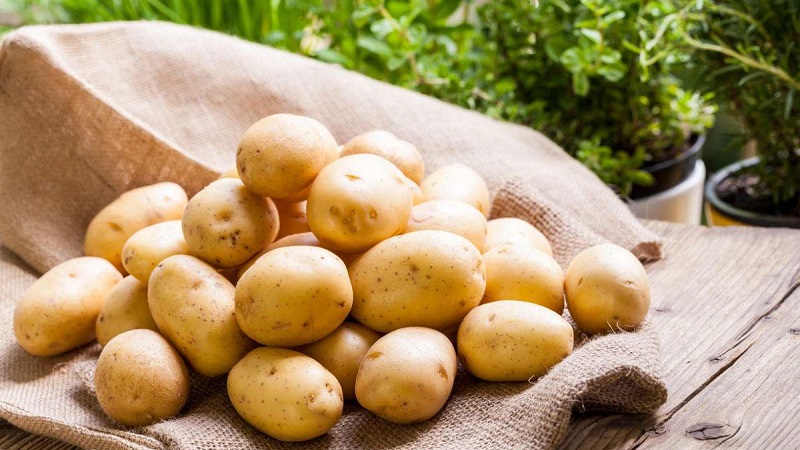
The pulp is light yellow, has a pleasant taste, does not darken for a long time in the open air and retains its shape during heat treatment.
Variety characterized by a consistently high yield: 10-15 tubers are formed on one bush, from 1 hectare of land an average of 200-230 centners of potatoes are harvested.
Which regions is best suited for
Grow farm potatoes possible in any region with a temperate, continental or sharply continental climate, therefore, it is successfully cultivated in Ukraine, Belarus and practically in all regions of Russia.
Other varieties of potatoes:
Difference from other varieties
Let's make a comparative analysis. The table shows the main indicators of different varieties.
| Variety | Productivity, c / ha | Tuber mass, g | Keeping quality,% |
| Farmer | from 200 | 90-110 | 95 |
| Kiranda | 110-320 | 90-175 | 95 |
| Riviera | 280-450 | 100-180 | 94 |
| Zhukovsky early | 350-450 | 100-120 | 92-96 |
| Veneta | 250-350 | 70-95 | 87 |
| Karatop | 200-500 | 60-100 | 97 |
| Minerva | 200-450 | 120-245 | 94 |
| Meteor | 200-400 | 100-150 | 95 |
The main advantages and disadvantages of the variety
Farmer variety has a lot of positive characteristics:
 great taste;
great taste;- early maturation;
- high productivity;
- long-term storage;
- the ability to grow in various climatic conditions;
- resistance to degeneration and most diseases.
Minuses:
- tendency to late blight with prolonged presence of tubers in the ground;
- the need for a nutritious and moderately moist soil;
- the need to regularly process the beds from aphids, cicadas and Colorado beetles.
Features of planting and growing
Potatoes Farmer can be grown from seeds and tubers... In the first case, the planting material must first be soaked in water for 2 days, and then placed on a damp cloth and left in a warm place for germination.
Spread the germinated seeds on the surface of the soil, sprinkle with loose earth or sand and cover with foil. Remove the film after emergence. After 2 weeks, pick into separate containers. When 4-5 leaves appear on the seedlings, transplant into open ground.
Seed tubers are also needed pre-germinate for 7-10 days in a bright and warm place.
Training
Before planting potatoes the ground needs to be prepared as follows:
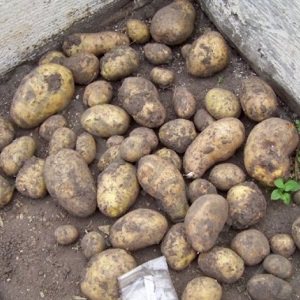 in the fall to clear of weeds and debris;
in the fall to clear of weeds and debris;- dig up to a depth of about 30 cm before frost;
- in the spring it is good to loosen the soil surface;
- 2-3 days before planting, apply complex mineral fertilizers containing potassium, phosphorus and nitrogen, as well as humus, rotted manure or peat to the soil;
- to reduce the risk of developing diseases, before planting, treat with fungicides, for example, Prestige.
Timing, scheme and landing rules
The timing of planting potatoes in open ground depends on the type of planting: tubers should be planted in early or mid-May, seedlings in the first half of May.
Reference. The seedlings should be at least 30 days old at the time of transplanting in open ground, so the seeds should be sown at the end of March.
It is important to ensure that at the time of planting there are no night frosts at all, and the average daily temperature does not fall below + 10 ... + 15 ° C.
Scheme:
- divide the site into even rows at a distance of 60 cm from each other;
- dig small depressions in them with an interval of 20-25 cm;
- pour humus, peat and wood ash on the bottom of each, pour in a little water;
- remove seedlings from individual containers along with a clod of earth;
- place them in prepared holes, leaving 3 sheets above the soil surface;
- sprinkle the roots with loose soil;
- cover the beds with foil for the speedy rooting of seedlings;
- raise the film for airing every day, and after the plants have adapted to the open air, remove it.
Tubers should be planted in the same way.by placing them sprouts up.
See the end of the video at the end of the article.
Growing features
For successful potato growing some rules must be followed:
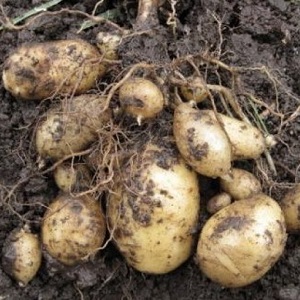 for the speedy growth of the tops and the rapid ripening of tubers, the crop should be planted in a well-sunlit area;
for the speedy growth of the tops and the rapid ripening of tubers, the crop should be planted in a well-sunlit area;- exclude cold drafts that weaken the immunity of plants and contribute to the development of late blight;
- choose a site with a high level of groundwater occurrence, which will prevent potatoes from dying during dry periods.
It is not recommended to plant potatoes after nightshades... The best crop precursors are legumes, grains, cabbage, cucumbers, carrots, peppers, and garlic.
Important! Potatoes can be planted on the same plot no earlier than after 3 years.
The soil should be light and fertile, contain black soil or sand... It is important that it allows air, water and solar heat to pass well - this will have a beneficial effect on the development and maturation of tubers.
The nuances of care
To get a good harvest, you need to properly care for your potatoes.
At least 2 times, when the bushes reach 12-15 cm in height and 20 days after that, you need to spud the culture, and to retain moisture and prevent the growth of weeds, mulch the land with mown grass or straw.
Watering mode
Variety The farmer is picky about watering, especially during tuber formation... Drying out of the soil negatively affects the quality and volume of the crop.
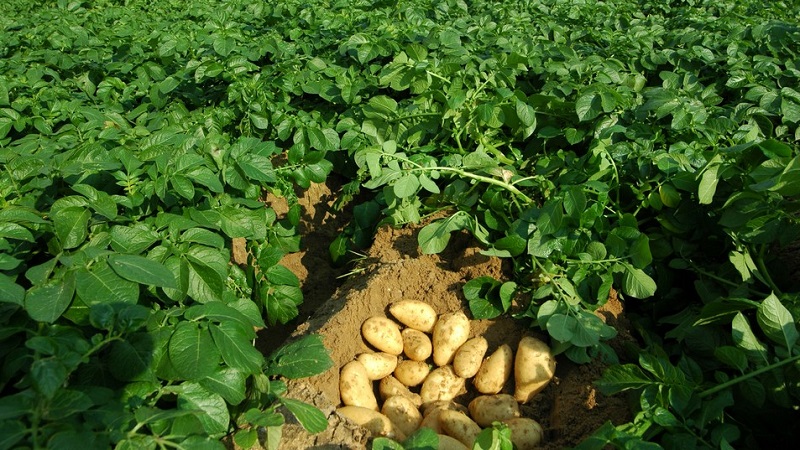
It is necessary to moisten the ground as the top layer of the soil dries out, pouring 3 liters of water under each adult bush. Under favorable weather conditions, 3 waterings are enough: after germination, during bud formation and at the end of the flowering period. To avoid moisture evaporation, watering is best done in the evening.
Reference. For even wetting, it is better to use a drip irrigation system.
Each field should be loosened up the soil... If this is not done, the earth becomes compacted, and its ability to pass air decreases, and a lack of oxygen leads to wilting of the tubers.
Top dressing
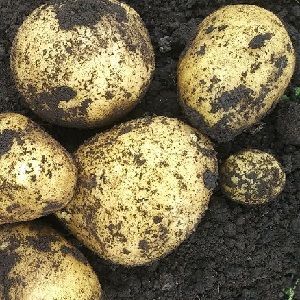 During the entire growing season, the culture you need to feed at least 2-3 times:
During the entire growing season, the culture you need to feed at least 2-3 times:
- 2 weeks after germination;
- during flowering and tuber formation.
You can use mineral and complex fertilizers (urea, potassium sulfate, ash, "Ammofosku"), as well as organic fertilizing in the form of diluted manure, poultry droppings, herbal infusions made on the basis of any weeds.
Foliar feeding is required, for example, spraying bushes with a superphosphate solution.
Read also:
Disease and pest control
The variety is resistant to potato cancer, viral diseases, golden cyst nematode... However, there are other diseases and pests that affect mature plants.
| Pest / disease | Description | Control methods |
| Colorado beetle | Small beetles with striped wings. Their larvae feed on the tops and destroy the green mass of the plant. | If there are few larvae, they can be collected by hand. In the event of mass destruction, treatment of plants with special preparations ("Prestige", "Aktara") is required. |
| Aphid | Small insects that live on the surface of leaves and suck sap from them. The presence of aphids is indicated by the appearance of a sticky plaque on the surface of the bushes, leading to the development of fungal diseases. | Plants should be treated with a decoction of onion husks (200 g per 2 liters of water) or with Actellik insecticide. |
| Cicadca | Small green insects that feed on sap from stems and leaves, causing the bushes to turn yellow and dry out. | Treatment with special chemicals ("Karate Zeon") is required. |
| Late blight of tubers | The infection affects tubers if they are in the soil for a long time, especially in rainy and cool weather. Dark spots form on the potatoes, gradually increasing in size. The tubers rot. | Diseased plants must be removed from the site. Treat the rest of the bushes with the antifungal drug Ridomil. |
Growing difficulties
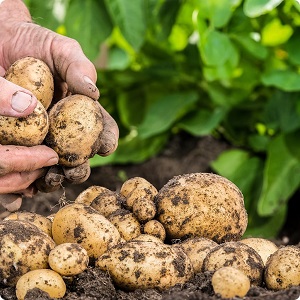 Growing potatoes A farmer from seeds or tubers is economically viable, but some difficulties may be encountered in the process:
Growing potatoes A farmer from seeds or tubers is economically viable, but some difficulties may be encountered in the process:
- lack of preliminary soaking of seeds leads to poor germination;
- excessive deepening of the hatched seeds leads to their decay;
- the ingress of water on the sprouts during watering the seedlings is the reason for the development of the black leg;
- seedlings can be too stretched and tangled - this interferes with the pick.
It is important to follow the rules of agricultural technologyto avoid such problems.
Harvesting and storage
The ripening period of tubers is influenced by the climatic conditions of the region and the method of cultivation.... You can understand that the potatoes are ready for harvesting by the massive yellowing of the tops.
How and when to collect
You can start harvesting at the end of July - mid-August, that is, 50-60 days after planting, and in case of favorable weather conditions and proper storage of seed tubers - after 40-50 days.
You need to harvest on a sunny warm day, carefully digging in the bushes with a shovel and manually selecting the tubers. The harvested potatoes should be peeled from the ground and placed in baskets to avoid mechanical damage.
Storage features and keeping quality of the variety
Tubers must be sorted out, discarding rotten and spoiled, leave a part for subsequent planting and remove the main crop for storage, after drying it in the shade under a canopy.
It is better to store potatoes in wooden boxes in a dark room. with moderate humidity and good ventilation at a temperature of + 2 ... + 5 ° C. The keeping quality of tubers is at least 90%. Under proper conditions, the crop is stored until spring.
Tips from experienced gardeners and reviews
According to reviews, when growing potatoes Farmer from seed even experienced gardeners face problems therefore, it is better to start acquaintance with this variety with planting tubers.
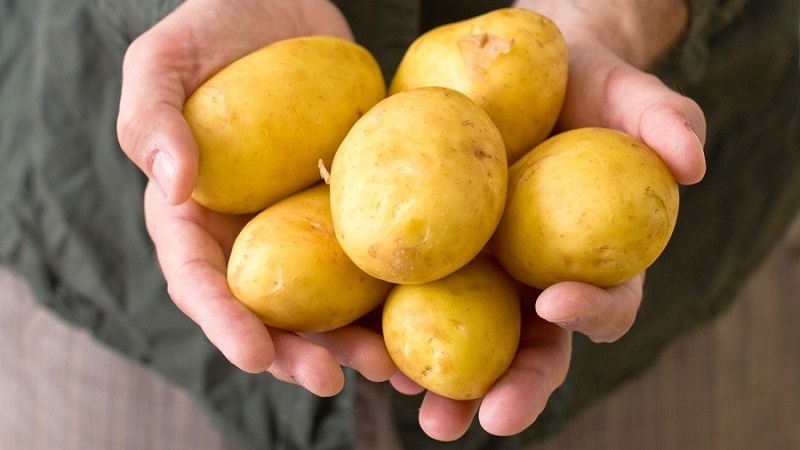
Vasily, Krasnodar: “We did not immediately become friends with this variety. First, they bought seeds, planted them and after 1.5 months they collected 4 kg of potatoes from 1 bag, and even the tubers were the size of a chicken egg. A year later, the tubers were planted and then they realized the charm of the variety: from 1 bucket of seed potatoes, 4 buckets of large, even tubers grew, as in the photo on the pack. The taste is excellent, the harvest is stored perfectly ".
Maria, Ufa: “Unfortunately, I have had a bad experience of growing a Farmer from seeds. I bought seeds from SeDeK, the instructions said to soak them in Energene on 18 March. I did so. They hatched after 5 days. I planted them in a tray, but only 1 sprout sprouted, and even that grew up to 1 cm and froze, and then it died altogether. ".
Conclusion
The farmer is suitable for growing in almost all regions of Russia, as well as in Ukraine and Belarus. The popularity of the variety is due to its high yield, resistance to most diseases and good keeping quality despite the early ripening period.